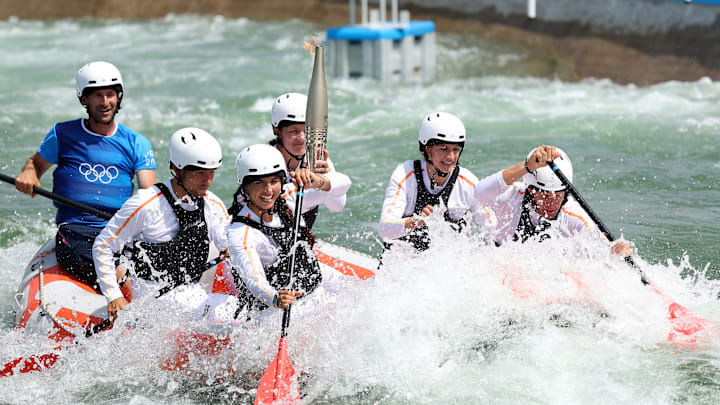On July 26, 2024, billions of people from around the world will tune in to watch the opening ceremony of the 2024 Summer Olympics in Paris, France. While it’s sure to have a different tone from the most recent Summer Games in Tokyo (2020), Rio de Janeiro (2016), and London (2012), one thing that will remain constant: the traditional lighting of the Olympic cauldron.
The Olympic torch is reignited months before each new cycle of the Games in a ceremony in Olympia, Greece. An actress playing an ancient priestess uses a parabolic mirror and the sun’s rays to set the torch relay in motion (if it’s cloudy on the day of the ceremony, they light the torch from a second torch that was lit in the parabolic mirror on a sunny rehearsal day).

Once the flame is reestablished, it’s up to thousands of torchbearers to ensure it makes it to its final destination safely. This year, after leaving Greece on a three-masted sailing ship and arriving in Marseille, the flame was carried by 10,000 torchbearers through 450 French towns on its way to Paris. The path from Greece to the Games can even take the torch underwater, as it did at the 2000 Summer Olympics in Sydney, Australia, when a special underwater flare was employed to send the flame over the Great Barrier Reef.
The intention is for the flame to stay continuously lit throughout its entire journey, but there’s almost always difficulty at some point along the route. One journalist reported that the flame was extinguished at least 44 times on its way to the 2014 Winter Olympics in Sochi, Russia, and the Rio relay for the 2016 Summer Games saw its fair share of mishaps as well. On June 20, 2016, a jaguar that was part of the relay was shot and killed after it escaped from its handlers and reportedly lunged at a soldier; several days later, a Brazilian man attempted to douse the torch as it passed through his town. Just days before the ceremony, protestors actually shut down the torch procession in Angra dos Reis, Brazil, stealing it from the torchbearer and extinguishing the flame.
Sometimes it’s Mother Nature who extinguishes the torch. In 2013, it had to pass through what amounted to a wind tunnel at the Kremlin, where it fell victim to a particularly persistent gust. It was quickly re-lit by a security agent’s Zippo. (That’s a no-no, by the way. There’s protocol for relighting the flame, and it involves a backup torch also lit from the original source in Athens—not a random lighter.)
At the end of its journey, a torchbearer enters the opening ceremony venue and uses the flame to light the Olympic cauldron, which remains lit for the entire Games. It can be one of the most spectacular moments of the Games—like when Spanish Paralympic archer Antonio Rebollo Liñan shot a flaming arrow through the night sky to light the cauldron at the 1992 Summer Games in Barcelona.
When the flame does go out for good, it will be intentional; the snuffing ceremony on the final day of the 2024 Summer Games will put the flame to rest until the relay for the 2026 Winter Olympics in Milan and Cortina d’Ampezzo, Italy, begins.
Find More Answers to Your Summer Olympics Questions:
A version of this story was published in 2018; it has been updated for 2024.
